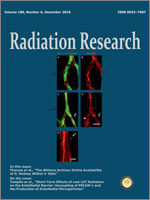Dr. H. Rodney Withers (1932–2015) (11, 2) was one of the preeminent radiation biologists of his time, beginning in the 1960s and spanning more than 4 decades. He was a translational researcher who recognized the importance of stem cells and who asked questions about biological systems relevant to clinical practice. Dr. Withers was the embodiment of a translational physician scientist well before the concept became popular. His preclinical mouse data provided clinical radiation therapists rational guidelines for making treatment choices easily understood and highly accessible. “The 4 R's of Radiotherapy” coined by him summarized the key mechanisms governing tumor and normal tissue responses to fractionated radiotherapy while providing the biological bases to alter dose fractionation schemes for clinical benefit. In many ways, providing the data based rationale for exploiting these responses sums up his legacy for the radiation sciences. Repair of sublethal damage preferentially spares late responding normal tissues. Reassortment of surviving cells within the division cycle resensitizes rapidly proliferating cells. Reoxygenation of hypoxic cells during fractionated treatment radiosensitizes tumors. Repopulation of surviving clonogenic cells during a course of treatment is a hazard best minimized in the case of tumors and encouraged for acute responding normal tissues.
Prior to his death from Parkinson's disease in 2015, his long-time colleagues Kathy Mason and Howard Thames discussed with him about making his immense data base of normal tissue responses available to the worldwide scientific community by converting his handwritten lab notebooks into searchable digitized data files. Dr. Withers wholeheartedly agreed and over a span of 4 years, tens of thousands of animal observations were digitized by Nancy Hunter into the “Withers Archive”. Some of these results have never been analyzed or published, and as we and former collaborators enter retirement it would have been impossible for future investigators to gain access to his data. For this reason, we have digitized the contents of the lab notebooks. It was Rod's hope and ours that this data will have interest to newer scientists in the fields of radiation oncology and biology and their future use of this data base will continue to benefit cancer patients now and in the future. In this note we wish to explain the mechanism we have set up to make the raw data contained in the “Withers Archive” available to researchers online.
Organization of the Data
The data have been stored in 23 Microsoft Excel files whose contents are briefly described in Table 1. The files are grouped either by tissue (e.g., jejunum) or the nature of the end point (e.g., acute skin reaction). The experimental design is briefly described. Relevant publications (when available) are cited for each file.
TABLE 1
Each of the 23 Excel files contains two sheets. The first sheet, titled “Explanatory”, sets out the details of the experiments, including radiation source, strain of mice, fractionation schedule, etc. In addition, the details of the data formatting are explained. The second sheet, titled “Data”, contains the digitized data.
A researcher who is interested in obtaining portions of this data would begin by identifying what parts are wanted, according to the terminology used in Table 1. Afterward, please ensure that this terminology is used when contacting staff at the Center for Radiation Oncology Research (CROR) at MD Anderson Cancer Center (as explained in more detail below).
Two-Step Exchange of Emails to Obtain the Data
First step.The requestor identifies the tissues/end points of interest from Table 1. The requestor then sends an email to the staff at CROR (CRORadmin@mdanderson.org) requesting more detailed information. The staff at CROR will then match the requested tissues/end points (using the terminology from Table 1) to various “synopses”, which set out the contents of the Excel files in detail. The appropriate synopses will be emailed to the requestor.
Acknowledgment of Re-publication
If the data provided as described in this note are used in any future publications, it is requested that the following acknowledgment be cited: “Data used in this study were obtained from the Withers Archive, the digitization of results from the research groups of H.R. Withers and his colleagues were provided by the Center for Radiation Oncology Research at the MD Anderson Cancer Center”.






